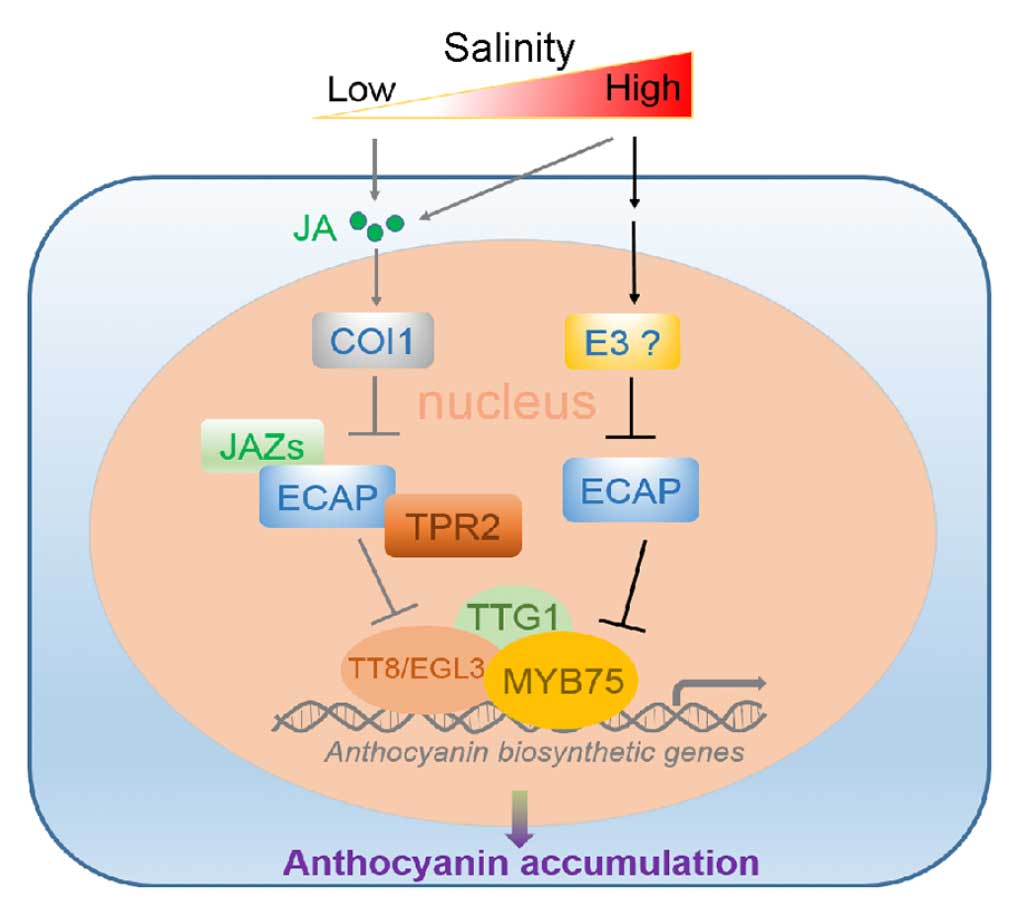博文
New Phytologist:拟南芥响应不同水平盐胁迫时的花青素合成的分子调控机制
||
ECAP is a key negative regulator mediating different pathways to modulate salt stress-induced anthocyanin biosynthesis in Arabidopsis
第一作者:Changjiang Li
第一单位:中国农业大学
第一通讯:Ying Fu
Abstract
背景回顾:Anthocyanins are a subgroup of plant flavonoids with antioxidant activities and are often induced by various biotic and abiotic stresses in plants, likely to efficiently scavenge free radicals and reactive oxygen species. 提出问题:However, the regulatory mechanisms of salt-stress-induced anthocyanin biosynthesis remain unclear. 主要发现:Using molecular and genetic techniques we demonstrated key roles of ECAP in differential salt-responsive anthocyanin biosynthesis pathways in Arabidopsis thaliana. 研究基础:ECAP, JAZ6/8, and TPR2 are known to form a transcriptional repressor complex, negatively regulate jasmonate (JA)-responsive anthocyanin accumulation. 结果1-中等盐胁迫,JA信号降解JAZ,但不降解ECAP:In this study, we demonstrated that under moderate salt stress, the accumulation of anthocyanins is partially dependent on JA signaling, which degrades JAZ proteins but not ECAP. 结果2-高盐胁迫,ECAP被降解且不依赖于JA信号:More interestingly, we found that high salinity rather than moderate salinity induced the degradation of ECAP through the 26S proteasome pathway, and this process was independent of JA signaling. 结果3-非高盐胁迫,ECAP结合并抑制MYB75转录活性,负调控花青素合成:Further analysis revealed that ECAP interacts with MYB75 (a transcription factor activating anthocyanin biosynthetic genes) and represses its transcriptional activity in the absence of high salinity. 结论:Our results indicated that plants adopt different strategies for fine-tuning anthocyanin accumulation under different levels of salt stress, and further elucidated the complex regulation of anthocyanin biosynthesis during plant development and responses to environmental stresses. 摘 要 
花青素是一类植物类黄酮物质,具有抗氧化活性,在植物中受到多种生物和非生物胁迫的诱导,从而作用于消除植物体内多余的自由基和活性氧物质。但是,有关盐胁迫诱导花青素生物合成的分子调控机制还不清楚。利用分子和遗传技术,作者在本文中揭示了拟南芥ECAP在差异盐响应花青素生物合成通路中的关键作用。ECAP、JAZ6/8和TPR2能够形成转录抑制复合体,负调控响应于茉莉酸的花青素积累。在本文中,作者发现在中等盐胁迫下,花青素的积累部分依赖于茉莉酸的信号转导,其能够降解JAZ蛋白,但不能降解ECAP蛋白。有趣的是,作者发现更高水平的盐胁迫会诱导ECAP蛋白经过26S蛋白酶体途径被降解,并且该过程独立于茉莉酸信号转导。进一步的研究显示,ECAP能够与MYB75互作,而后者是一种能够激活花青素生物合成基因的转录因子,ECAP能够在没有高盐浓度时抑制MYB75的转录活性。本文的研究结果揭示了植物演化出了在不同盐胁迫水平下,精细调控花青素积累的不同策略,并解析了植物发育过程中和响应环境胁迫时花青素生物合成的复杂调控机制。 通讯作者 ** 傅 缨 **
个人简介: 1993年,华中师范大学,学士; 1999年,武汉大学,博士; 1998-1999年,香港大学,助理研究员; 1999-2004年,加州大学河滨分校,博后; 2004-2007年,加州大学河滨分校,助理项目科学家; 2007年-至今,中国农业大学,教授。 研究方向:主要从事植物细胞形态发生过程中细胞生长控制机理的研究。深入研究了ROP GTPase如何响应生长发育信号(如激素)和环境信号(如非生物逆境胁迫),通过调控细胞骨架决定植物细胞极性生长和形态发生的分子机制。
doi: https://doi.org/10.1111/nph.17937
Journal: New Phytologist
Published date: December 23, 2021
https://blog.sciencenet.cn/blog-3158122-1319835.html
上一篇:Molecular Plant:5个山羊草属Sitopsis物种基因组揭示小麦B套亚基因组的起源
下一篇:The EMBO Journal:拟南芥BES1与热休克转录因子HSFA1互作,促进植株热胁迫抗性
全部作者的其他最新博文
- • Plant Physiology:CsMADS3促进柑果中的叶绿素降解和类胡萝卜素合成(华中农业大学)
- • Molecular Plant:LBD11-ROS反馈调节作用于拟南芥的维管形成层增殖和次生生长(浦项科技大学)
- • Science Advances:根结线虫通过调控植物的CLE3-CLV1模块,促进侵染进程(日本熊本大学)
- • Nature Communications:油菜素内酯参与植物营养生长期转变的分子机制解析(浙江农林大学)
- • Current Biology:光合作用产生的蔗糖驱动侧根“生物钟”(德国弗莱堡大学)
- • PNAS:花同源异型基因在叶中被抑制、花中被激活的分子机制(南卡罗来纳大学)